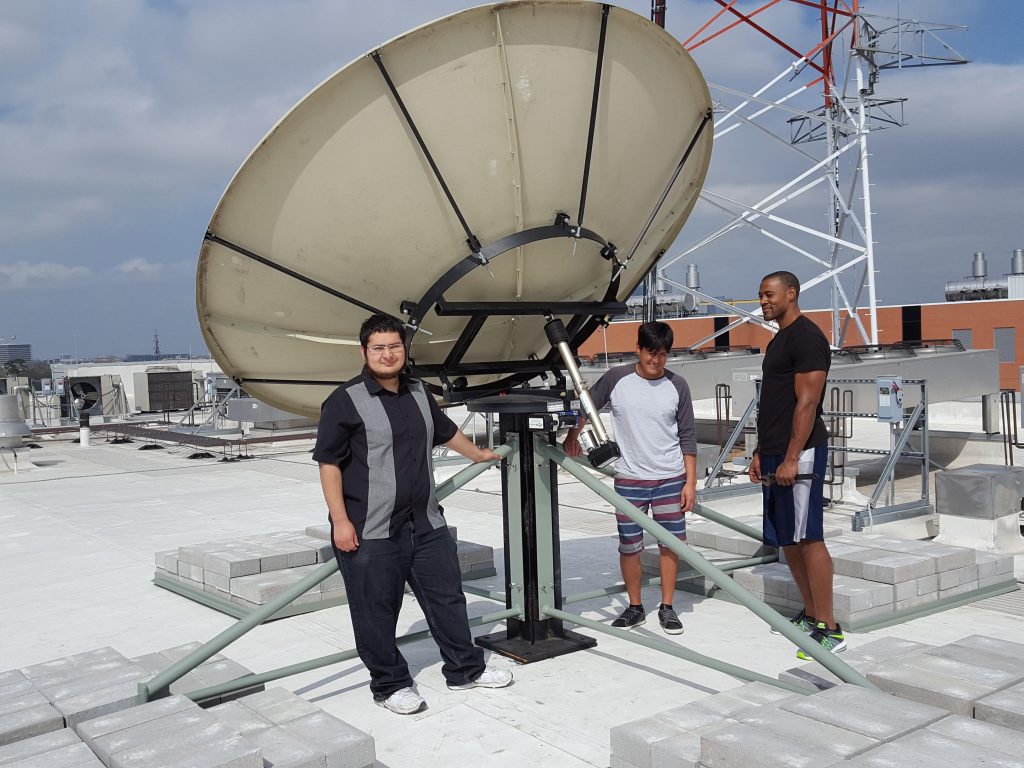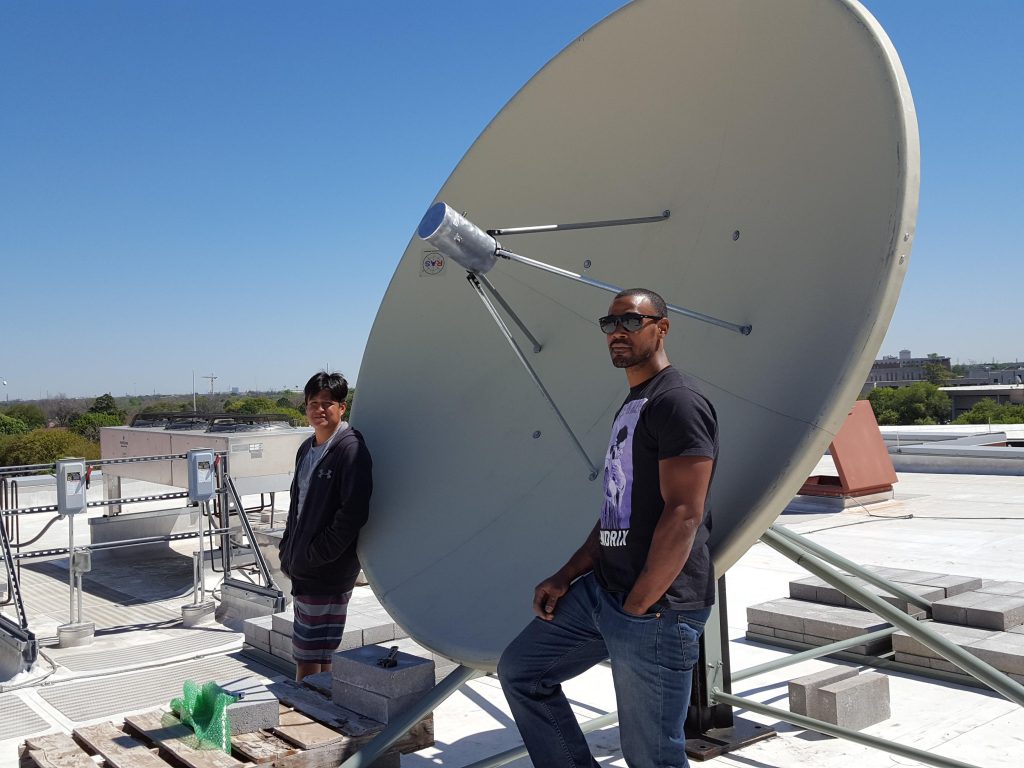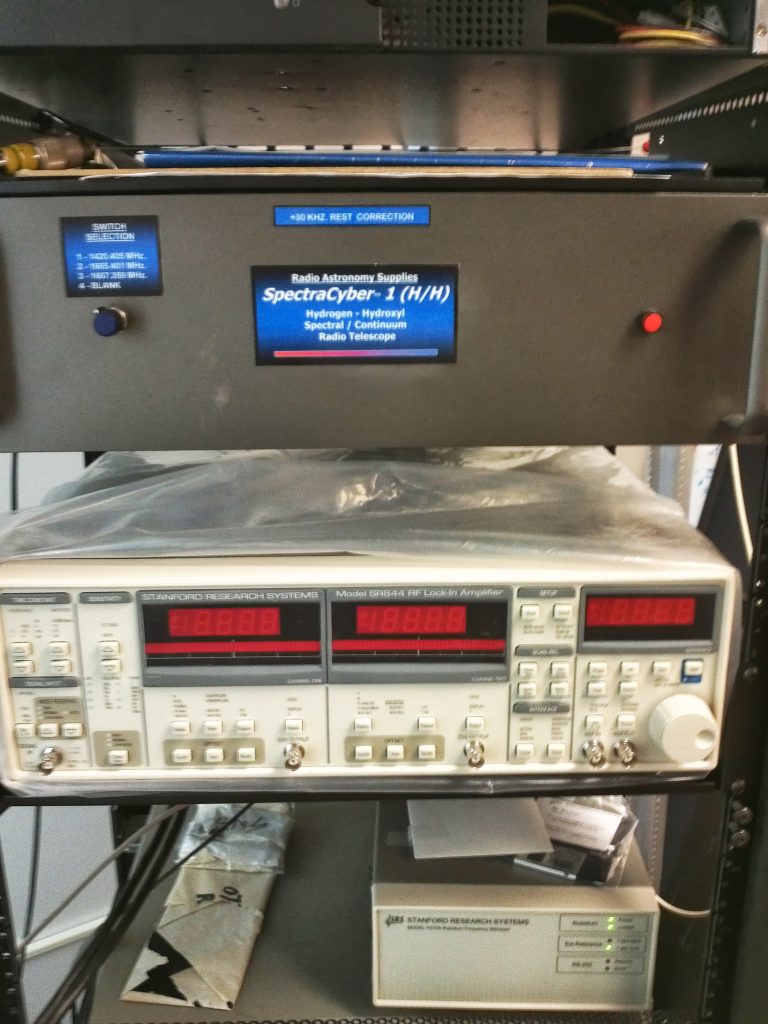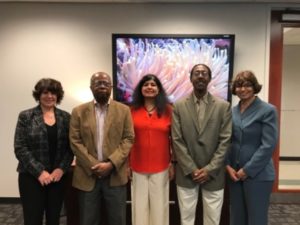or keep pressing Tab key no navigate
When: 09/21/2023
Where: TECH 216

September 13, 2023
Location: SB 156
Time: 12:00 pm
Presenter: Dr. Ejiro Umaka
Probing the quark-gluon plasma with the sPHENIX detector
Abstract: sPHENIX is a new RHIC detector designed for high precision measurement of jets and heavy flavor probes of the quark-gluon plasma (QGP). sPHENIX is equipped with a suite of tracking detectors for vertexing, timing, and momentum measurement; calorimeters for photon, electron, hadron and jet measurements; and event characterization detectors for centrality and event plane measurements. sPHENIX’s first data began in late May 2023 primarily to commission the detector. Several physics observables including and not limited to jet correlations, jet substructure, open heavy flavor and upsilons are planned measurements with this year’s data and with data in the upcoming run in 2024.
This talk will discuss probes of the QGP and sPHENIX readiness for these measurements.
Ejiro Umaka did her PhD work on ALICE at the LHC at CERN, which was granted to her in 2020 by the University of the Houston. She studied the QCD crossover temperature via net-particle fluctuation measurements in Pb-Pb collisions. She joined the sPHENIX collaboration at RHIC and the ATLAS collaboration at the LHC in 2020 studying jets and event plane dependent observables while she was a postdoctoral associate at Iowa State University. In 2022, she joined Brookhaven National Laboratory as a postdoctoral researcher where she continues to work on jet and flow related observables in sPHENIX. She is currently serving as sPHENIX juniors’ committee co-chair, software coordinator for sPHENIX event plane detector; and she is an avid yoga practitioner.
Light lunch will be provided.

Located on the roof of the Spearman Technology Bldg the Department of Physics has installed a 3m antenna plus the electronic equipment to conduct observations at a wavelength of 18cm. In addition, we have a simple multi-channel autocorrelator to process the signal and additional software for calibration. Finally, we also own a CASPER-ROACH dual correlator for high-resolution multi-frequency processing.

With the standard setup we can detect the galactic Neutral Hydrogen (HI) and the 1665/1667 MHz OH MASER transitions in star forming regions and late-type stars. While HI emission allows us to track and map the morphology of the Milky Way galaxy; OH, H2O and CH3OH MASERs allow us to study particular periods of the star formation process. One of the major advantages of radio astronomy is that it detects radiation in regions where optical telescopes cannot. Due to large amounts of gas and dust in these regions visible radiation does not find is way through. Also, the physical processes in these regions are low energy driven so they can only be observed and studied in the radio and infrared regimes of the electromagnetic spectrum.

Researchers have also access to National and International observatories like: Very Large Array (VLA), Very Large Baseline Array (VLBA) in the USA, European VLBI Network (EVN) and MERLIN (UK) to study the radio emission in various fields of research. The future of Radio Astronomy is very bright and promising. In the last decade new multimillion-dollar arrays with the latest instrumentation and technologies have been built like ALMA (mm-array in Chile) and SKA (square km-array in So. Africa & Australia).

JOINT MATHEMATICS & PHYSICS COLLOQUIUM
Non-Relativistic Fermionic Quantum Mechanics (Cracking Schrödinger Nutshell)
Young Lee
Department of Physics, Texas Southern University
Young.Lee@tsu.edu
Tuesday, September 25, 2018 2:30 pm – 3:30 pmTexas Southern University Science Building, Room 146
Abstract
The non-relativistic Schrodinger equation was formulated nearly 90 years ago and has been successfully applied to various quantum mechanical systems across multiple scientific fields producing the main developments to quantum theory. The primary importance of Schrodinger’s equation arises in the implementation of the analogue of Newton’s law and continuation of classical mechanics. In the development of relativistic quantum physics, Dirac expanded the theory combining Einstein’s special relativity, quantum mechanics and the so- called fermion particle of half integer spin. This was the first theory to consistently account for special relativity within the context of quantum mechanics. In this paper, we formulate a novel mathematical approach to solve Schrodinger’s equation within the context of particle and wave theory. In our examination, we present a similar, yet unique model of fermion structure, which is consistent with the present day Dirac description. We will introduce and discuss the 1 dimensional structure of a Harmonic oscillator and free particle fermionic state. Additionally, the 3+1 dimensional structure of the fermionic state will be briefly outlined. Finally, we will compare our model with Dirac’s theory for further study. This model is not Lorentz invariant; however, the connection of classical and non-relativistic quantum theory will be explained. We will also talk about the Hydrogen atom within the framework of bound state, fermionic quantum physics.
Download the flyer .

From Left to right: Dr.Saydam (CO-I), Dr.Sapp (CO-I), Dr.Sundaresan (PI), Dr.Harvey (CO-PI), Dr.Peltier-Glaze (CO-I)
TSU was recently awarded a National Science Foundation Targeted Infusion Grant under PI, Dr. Alamelu Sundaresan, with Co-PI Dr. Mark Harvey and CO-Is Drs. John Sapp, Azime Saydam and Bernnell Peltier-Glaze. This project combines structured peer-mentor infused curricula coupled with faculty mentored summer research for the following courses within COSET: MATH 136, CHEM 131, PHYS 237 and BIOL 131. The main objective of the proposal is to increase STEM retention of underrepresented students by offering dedicated peer mentoring and supervised faculty research opportunities. We are excited about this first full-fledged project of its kind at TSU consisting of an active learning concept and associated peer-mentoring, which will benefit both TSU students and the above four departments from June 2017 – May 2020. Peer mentors will be selected from upperclassmen in each of the departments and will be directly supervised by the PI, Co-PI and CO-Is. More to follow…
Dr. Perotti is currently working in collaboration with Dr. D. Bessis on the development of a new method in the spectral analysis of noisy time-series data for damped oscillators which makes use of J-matrices to evaluate Padé Approximations built on the time-series Z-transform. Applications of the method range from the detection of Gravitational Wave Bursts to the analysis of Magnetic Resonance data.
While in In Atlanta Dr. Perotti perfected codes which -starting from a suitable Pade’ approximant of the desired transmittance- reconstructed, through inverse scattering techniques, the corresponding monodimensional effective self-consistent potential having no bound states. In collaboration with Dr. A. Mezincescu he also wrote codes to calculate and subtract from the potential thus obtained the self-consistent field for a given density of donor dopant ions and finally –trough a change of coordinates- obtain the chemical composition profile (solution of the variable mass BenDaniel and Duke’s equation). The technique allows to efficiently design semiconductor heterostructures given the desired electron reflectance. They furthermore developed codes that, using double Darboux transformations on a given monodimensional potential with one bound state, maximize the asymmetry of the continuum function at a given energy having nonzero dipole matrix element with the bound state. The potential thus obtained optimizes the probability for an electron excited by incident light of a given frequency to be emitted in the desired direction. While In Munich Dr. Perotti developed -for comparison with laboratory experiments- semiclassical and full quantum Monte Carlo simulations of an ion moving in a one-dimensional optical lattice and a weak confining static electric field while at the same time being subject to a periodic driving force. The solution of the Fokker-Planck equation for the system in the diffusion limit, found in collaboration with Dr. V. Alekseev of the Lebedev Physical Institute in Moscow, allows to explain the apparent rise of the spatial diffusion coefficient when increasing the periodic force amplitude. In Pittsburgh Dr. Perotti worked on Classical numerical simulations and calculation of the Lyapunov exponents for a system consisting of an ensemble of (two-level) Rydberg atoms collectively interacting with its own selfconsistent field and an external microwave field in a cavity. By changing the strength of the external field and/or its detuning from the chosen atomic transition, the behavior of the system can be made to change from regular to weakly chaotic and finally to strongly chaotic. The system moreover offers a convenient way to change the total action by varying the number of interacting atoms. It is therefore considered a convenient system to explore the different dependence on the total action of the time at which quantum evolution begins to significantly deviate from the classical one in the case of regular and chaotic systems [G. P. Berman, E. N. Bulgakov and D. D. Holm, Los Alamos Report LA-UR-93_2187 (1993)]. In the first case this time -called “quantum break-time”- is expected to be a polynomial function of the action, in the latter a logarithmic one. His simulations were aimed at identifying the parameter ranges for the different regimes (regular, strongly chaotic, weakly chaotic) and finding their signature in the (averaged) quantities to be measured in the laboratory. He also conducted Classical and quantum simulations of the monodimensional hydrogen atom in a pulsed microwave field and a collinear constant static electric field, both with and without noise. These were compared with experimental results for atoms prepared in extreme Stark states in a static electric field and made to interact with a pulse of microwaves polarized collinear to the static field used to align the atoms. Furthermore he calculated the instantaneous quantum quasienergy (Floquet) levels for the above system and the Husimi functions of the corresponding states and of the projections on those states of the pulsed wavefunction to help interpret the results of the above quantum numerical simulations. In particular he was able to show the relevance of small classical phase space structures to pulsed quantum evolution. In Milano Dr. Perotti helped develop the codes used to numerically investigate the quantum dynamical localization in action (principal quantum number) of the electron probability for a mono (and bi-) dimensional hydrogen atom in a microwave field when the corresponding classical system is chaotic. He has applied similar techniques to the study of the stochastic ionisation of Alkali-metal atoms: microwave experiments with Alkali atoms are easier to perform than with Hydrogen; on the other hand, core effects cause significant deviations from the hydrogenic behaviour. The numerical simulations published by A. Buchleitner and his collaborators are in very good agreement with the laboratory experiment but are very time consuming; moreover only very qualitative arguments and no model has yet been advanced to interpret the regimes where Alkali ionisation deviates from that of Hydrogen. For regime II of A. Buchleitner and coworkers, where quantum effects are still dominant, Dr. Perotti developed an evaluation of the ionisation threshold based on the similarities between the phase space structures of Alkali in monochromatic microwave fields and Hydrogen in a bichromatic field. He has also shown that in the regime of very low microwave frequencies (regime III of A. Buchleitner and coworkers), a classical explanation is possible in terms of Chirikov’s criterion for transition to chaos. Recent research interests of Dr. Perotti also include the quantum double pendulum: a low dimensional autonomous system which in the classical limit displays chaotic behavior . It is simple enough to allow an extensive study which will be able to shed light on more complex chaotic autonomous systems being studied currently: e.g. the Hydrogen atom in crossed static electric and magnetic fields and the Helium atom. He has performed a study of energy curves and compared Husimi functions of eigenstates at important avoided crossings with the corresponding classical surfaces of section. He is now studying the behavior of suitable packets.
All students pursuing careers in the STEM as well as non-STEM areas must take one of the three service physics courses: Physical Sciences (for non-STEM-majors), College Physics (I & II, consisting of a comprehensive overview of laws of physics, without using calculus), and University Physics (I & II). The latter involves the use of calculus, which is the natural mathematical language of physics.
In addition to the lectures, there are accompanying Labs for College Physics and University Physics. These labs are intended to reinforce basic physics concepts through a “hands-on” approach emphasizing the statistical theory of measurements, and experiencing, first- hand, many of the fundamental laws of Newtonian physics as it impacts mechanics and gravity. These labs introduce students to basic topics such as fluids, waves, and thermodynamics (heat).
The more advanced Undergraduate Physics lab II introduces students to basic topics such as electricity and magnetism, optics, and modern physics. Students acquire a basic understanding of all these areas through experiments designed to reinforce the lectures. All of these topics are indispensable to the careers pursued by the diverse body of professional interests represented in our students, both majors and non-majors. Students with these skills and knowledge are in high demand in many professions (health sciences, pharmacy, education, engineering, aeronautics, etc.).
These labs are the cornerstone of a student’s immersion into, and understanding of, physics. These Labs will prepare students not only in the technical preparation of physics, but also in the scientific method of empirical research impacting all the sciences. Students will learn team work, sharpen their advanced mathematics skills (i.e. vectors, trigonometry, algebra, and statistical analysis), and develop critical thinking skills based on direct interaction with experiments.
The Medical and Nuclear Physics Teaching Lab builds upon the successful implementation of a Health Physics program at TSU begun in 2008. Health Physics concerns the understanding of nuclear processes as it affects safe working environments for living organisms (i.e. human beings in particular), within medical facilities, nuclear power plants, government research facilities, food processing centers, etc. Some of the equipment resources in this lab include:
Students enrolled in the traditional health physics program at TSU take two semesters of laboratory classes, which focus on unique hands- on experiments involving various radiation detection apparatuses, analyses, and techniques. In the first laboratory component, students learn how to use a Geiger-Mueller system to measure radiation emitted for various
radionuclide species. In the second installment of the laboratory sequence, students learn how to use a sodium iodide detector system to measure spectroscopic signatures from gamma-emitting radioisotopes. The final component in this sequence is a nuclear electronics laboratory, in which students learn fundamental signal pulse analysis using standard instrumentation commonly employed in nuclear and radiation physics.
Given that Houston hosts the world’s largest Medical Consortium, The Texas Medical Center (TMC), it is natural to expand upon proven Health Physics capabilities that overlap Medical Physics. This concerns the understanding of nuclear physics as applied to medical diagnosis and treatment for illnesses such as cancer. To this extent, the Medical/Health – Nuclear Physics Teaching Laboratory will also expand into this area. TSU- Physics has produced exceptional students working or interning as radiation safety specialists. A list of these facilities included the Nuclear Regulatory Commission, UT MD Anderson Cancer Center, UT Health Science Center at Houston, Texas Commision on Environmental Quality (Radiation Division), UT Southwestern Medical Center. Additionally, TSU-physics graduates have gone on to attend either graduate school or medical school at the following institutions: Texas A&M University at College Station, University of Texas at Austin, School of Medicine-Texas Tech Health Sciences, Howard University, Morgan State University, Tulane University.
Funding for the radiation health physics laboratories have been provided by grants from the Nuclear Regulatory Commission.
h3>DEPARTMENT OF PHYSICS
The Medical and Nuclear Physics Laboratory is a faculty research lab and also and a training facility for student researchers. This laboratory focuses on low energy nuclear physics, in which fundamental techniques are applied that are effective for detection and analysis of radiation levels impacting people in many workplace environments including nuclear power plants, medical diagnostic and treatment facilities, food processing plants, homeland security checkpoints, etc.
This Laboratory is also concerned with basic and applied research in nuclear physics. The “applied” thrust pertains to understanding related issues in the context of (1) medically related, radiation physics based, therapy and diagnostic applications impacting diseases; and (2) understanding the radiation thresholds in various workplace settings impacting organisms and the environment.
Selected students will participate in fundamental research projects emphasizing these two areas specified above. In addition, students will have an opportunity to participate in (1) high energy nuclear physics research at the Brookhaven National Laboratory and (2) nuclear astrophysics at the Facility for Rare Isotope Beams (FRIB) on the campus of Michigan State University. Besides mastering basic dosimetry and radiation detection skills developed within the curriculum, participating students will get to apply these skills in the prosecution of basic and applied research. Additional capabilities in Monte Carlo simulation studies in nuclear collision physics, radiation biophysics, radiation shielding and therapeutic applications of radiation will also be developed.
The objective is to develop a strong cohort of students that can pursue these studies at high powered facilities, eventually transitioning into professionals in the diverse areas of nuclear physics; e.g., heavy ion collision physics, nuclear astrophysics, radiation safety and protection, radiation therapy, diagnostic imaging and radiation biophysics. The advanced training received by selected students, developed within the context of prosecuting basic and applied research in medical, health, and nuclear physics, respectively will produce uniquely trained students able to enter the workforce in diverse areas such as nuclear facilities, government laboratories, medical treatment and diagnostic facilities, food processing plants, etc. Students can also pursue advanced training in health physics as a stepping stone to careers as radiation oncologists, radiation therapists, etc., within the medical profession. Houston hosts the world’s largest medical facility, the Texas Medical Center, with tremendous employment opportunities for such students. Some students can also elect to pursue a Ph.D. in medical physics or health physics – or even fundamental nuclear physics, in which the smallest constituents of matter are probed at the world’s most elite high energy physics facilities. In all cases, our physics students will have an abundance of career opportunities.
This is a research and student research training laboratory, emphasizing ongoing departmental research capabilities in noise filtering, atomic physics, and medical physics based research. Students learn modern Nuclear Magnetic Resonance (NMR) techniques which require an understanding of the underlying quantum physics associated with the spinning of atomic nuclei in an ambient, static, magnetic field and the spectrum of the electromagnetic radiation given off by these excitations. NMR is an important physical process with many applications including nuclear waste disposal and cancer detection in soft tissues. In the second case, Magnetic Resonance Imaging (MRI) is the conventional terminology encountered by many in cancer detection protocols. The NMR lab is equipped with the following equipment:
A typical experiment involves probe preparation, field configuration, pulse design, data acquisition and data processing. Students will become familiar with contemporary electronics and digital signal and image processing. Participating students will also learn how to do research as part of a team, each contributing a particular skill. The ultimate objective of the underlying research is to develop more cost effective techniques, requiring low level magnetic fields, for effective cancer detection.
This Laboratory represents a link to the outside world of expanded learning opportunities for our students. Students and faculty members will be able to participate in Distance Learning courses in specialized areas not represented within the Department.
This facility currently supports TSU-Physics’ participation within the Texas Physics Consortium (TPC) which includes eight other campuses across the State, pooling their curriculum resources and expanded faculty specializations (i.e. Astronomy, Cosmology, Geophysics, etc.). The other physics programs participating in the TPC include Midwestern State University, Prairie View A & M University, Texas A&M University-Corpus Christi, Texas A&M University-Kingsville, Tarleton State University, Texas A & M University – Commerce, West Texas A & M University, and Texas A & M University-Central Texas.
Expanding the course offerings available to TSU students will make them more competitive in their post-graduate career objectives. The production of well trained students is essential for sustaining TSU’s research activities. This classroom contributes to the learning process in a very modern way, ensuring the production of the best trained TSU students possible, able to impact ongoing, faculty led, research.